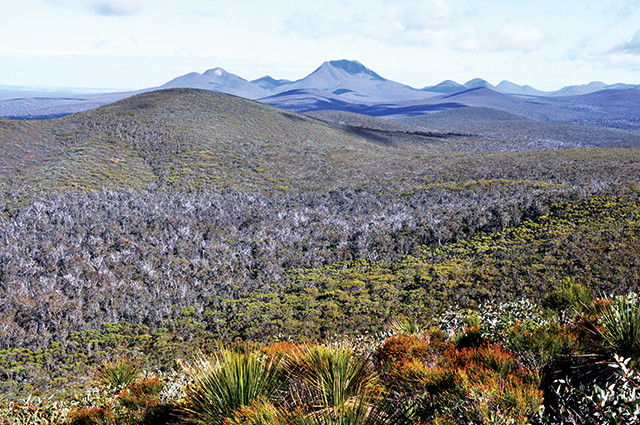
by Adityarup "Rup" Chakravorty Tuesday, April 19, 2016

Heath and scrubland vegetation cover this part of Stirling Range National Park in southwestern Australia. In the Late Cretaceous, central Australia may have looked similar, with a mosaic of low-growing and open vegetation and woody thickets. Credit: Raymond Carpenter.
Researchers have long thought that the scrublands of Australia developed over the last 25 million to 30 million years as part of a global trend toward colder and drier climates in which rainforests yielded ground to more open, fire-prone environments.
However, results from recent studies of fossil pollen suggest that open habitats were common across Australia far earlier. And now, the findings of a new study based, in part, on the first detailed analysis of Australian leaf fossils from the Late Cretaceous support the idea that open vegetation and the influence of fire on the landscape were widespread in Australia more than 66 million years ago.
“Our findings force us to question the idea that rainforests were the dominant biome throughout Australia 80 million to 60 million years ago,” says Raymond Carpenter, a paleontologist at the University of Tasmania and the University of Adelaide, both in Australia, and lead author of the new study published in the American Journal of Botany.
Carpenter and his colleagues extracted both microfossils — pollen and spores, for example — and macrofossils, such as leaves, from a soil core collected in the Bundey Basin of central Australia. Many of the species represented by microfossils found in the core had been observed previously and dated using stratigraphy at other locations. The team could thus use these known microfossils to determine the ages of specific sediment layers and leaf fossils in the core they studied.
The presence of leaf fossil fragments in the core, meanwhile, allowed them to draw a detailed morphological picture of the plants growing in that region 70 million years ago. The fossil leaves of at least three of the plants identified were “very small” — less"than 2.5 millimeters wide — and several of the leaf fragments examined “had stomata [pores used for respiration] located on both sides,” Carpenter says — both characteristics of plants adapted to grow in open environments, not rainforests.
In addition to the fossil leaf features that pointed to plants adapted to open environments, Carpenter’s team also found charcoal in the same sediment layers, which indicated that the ecosystem experienced episodes of burning.
Additionally, more than half of the fossil pollen was identified as belonging to various plants of the Proteaceae family, a major family of flowering plants in the Southern Hemisphere with more than 1,700 living species. Although modern members of Proteaceae “live in different habitats, several members live in open areas and are fire-adapted,” Carpenter says, yet another indication that scrublands, not rainforests, likely dominated vegetation in Late-Cretaceous Australia.
Fossils can be a keystone when building a picture of ancient ecosystems, says Michael Crisp, a researcher at the Australian National University in Canberra who was not involved in the study. “Fossils provide the only tangible, concrete evidence of the past,” he says, “but the fossil record is sparse and often quite patchy.”
It is rare to find in one location the combination of micro- and macrofossils analyzed by Carpenter and colleagues; that’s why their findings are compelling, says Maria A. Gandolfo, a paleobotanist at Cornell Un"versity who was not involved with this study. “This is probably the first paper in which [leaf] cuticle remains are used in combination with fossil pollen information to infer the presence of an entire biome,” she says.
While the microfossils and leaf fossils discovered and analyzed in this study support the idea that scrubland vegetation was widespread across Australia much earlier than previously thought, Crisp and Gandolfo both say they remain cautious about extrapolating an entire ecosystem from these fossils alone.
“It is, after all, one data point,” Crisp says: The fossils were derived from a single core.
Gandolfo shares this concern: “We only know approximately 5 percent of the fossil record, and as we discover more and more fossils, we tend to change our perceptions and therefore our conclusions,” she says.
Carpenter and his colleagues are working on examining materials from other cores, he says. But, he adds, the distribution of pollen and spores in the core examined in this study matches the pollen-spore assemblages [in other cores] of similar age, which he says gives him confidence that “in Late-Cretaceous Australia, instead of huge swaths of rainforest, there probably existed a mosaic of rainforest-type plants and open habitats influenced by fire.”
© 2008-2021. All rights reserved. Any copying, redistribution or retransmission of any of the contents of this service without the expressed written permission of the American Geosciences Institute is expressly prohibited. Click here for all copyright requests.